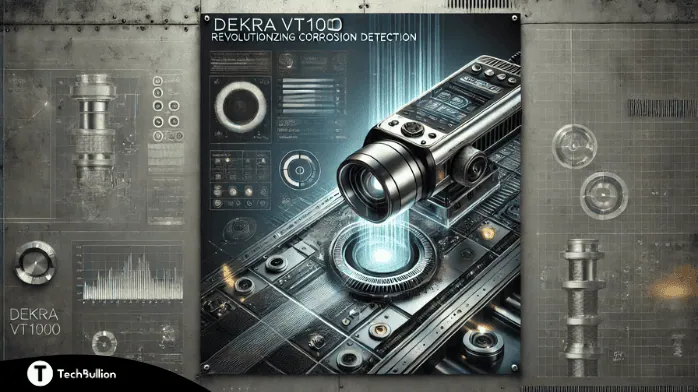
Corrosion remains one of the most significant challenges faced by industries reliant on metal components, particularly in sectors like oil and gas, aerospace, marine, and automotive. Among the various forms of corrosion, pitting corrosion stands out as one of the most insidious, causing localized damage that can compromise structural integrity.
To address this issue, the DEKRA VT1000 pitting images tool has emerged as a groundbreaking solution. Combining advanced imaging, automated analysis, and user-friendly features, the DEKRA VT1000 sets new standards in pitting corrosion detection. In this comprehensive guide, we’ll explore the significance of pitting corrosion, the innovative features of the DEKRA VT1000, its applications across industries, and how it benefits maintenance practices.
Understanding Pitting Corrosion
Pitting corrosion is a localized form of corrosion that results in the formation of small cavities or pits on a metal surface. While the damage may appear minor, the impact can be severe, leading to equipment failure and costly repairs.
Causes of Pitting Corrosion:
- Chloride Ions: Found in environments like seawater and industrial chemicals.
- Oxygen Deficiency: Stagnant areas or crevices are particularly vulnerable.
- Corrosive Chemicals: Exposure to acids, salts, or other aggressive substances.
Why Pitting Corrosion is Dangerous:
- Difficult to Detect: Pits are often small, hidden beneath coatings or in hard-to-reach areas.
- High Risk of Failure: Even minor pits can grow, leading to catastrophic structural damage.
- Expensive Repairs: Late detection can result in costly downtime, replacements, or repairs.
What is the DEKRA VT1000?
The DEKRA VT1000 pitting images tool is an advanced corrosion detection device designed to locate, analyze, and measure pitting corrosion with unparalleled precision. This innovative tool integrates high-resolution imaging, intelligent software, and portability, making it indispensable for industries that prioritize equipment reliability and safety.
Key Features of the DEKRA VT1000:
- High-Resolution Imaging: Captures clear and detailed images of metal surfaces.
- Advanced Lighting Systems: Eliminates shadows and highlights surface irregularities.
- Automated Data Analysis: Measures pit depth, width, and density with precision.
- Comprehensive Reporting: Generates detailed, easy-to-interpret reports for decision-making.
- Portable Design: Lightweight and robust, ideal for field inspections.
How the DEKRA VT1000 Works
The DEKRA VT1000 follows a streamlined process to detect and analyze pitting corrosion effectively:
1. Surface Scanning
Inspectors position the DEKRA VT1000 over the target surface. Its high-resolution cameras scan for irregularities, capturing images of pits and other surface defects.
2. Image Capture
Using advanced optics and lighting, the device photographs metal surfaces with incredible detail, even in challenging lighting conditions or on reflective materials.
3. Image Processing and Analysis
The DEKRA VT1000’s intelligent software processes the images, identifies pits, and calculates dimensions such as depth, width, and volume.
4. Reporting
The tool generates a comprehensive report, including visual data and measurements. Reports can be shared with maintenance teams to prioritize repairs.
Applications of the DEKRA VT1000 Pitting Images
The versatility of the DEKRA VT1000 makes it valuable across various industries:
1. Oil and Gas Industry
Corrosion in pipelines, storage tanks, and refineries can lead to leaks or explosions. The DEKRA VT1000 enables early detection of pitting, preventing costly accidents.
2. Aerospace Sector
Aircraft components made from aluminum alloys are highly susceptible to pitting. Regular inspections with the DEKRA VT1000 ensure critical parts maintain structural integrity.
3. Marine Industry
Saltwater environments accelerate pitting corrosion on ship hulls, offshore platforms, and underwater equipment. The DEKRA VT1000 helps assess and mitigate damage.
4. Automotive Industry
Exposure to road salts and moisture can cause pitting in vehicle chassis and engine components. The DEKRA VT1000 ensures these parts remain safe and functional.
Benefits of the DEKRA VT1000 Pitting Images
Investing in the DEKRA VT1000 offers numerous advantages for businesses focused on corrosion management:
1. Early Detection
The tool identifies pitting corrosion in its earliest stages, enabling timely maintenance and avoiding costly failures.
2. Accurate Measurements
With its advanced imaging and software, the DEKRA VT1000 provides precise data, ensuring targeted and effective repairs.
3. Improved Safety
By maintaining the integrity of metal components, the tool enhances safety in environments where failures could lead to severe consequences.
4. Cost Savings
Early intervention reduces the need for expensive replacements, downtime, or extensive repairs.
5. User-Friendly Design
The DEKRA VT1000 is portable and intuitive, making it accessible for field inspectors and requiring minimal training.
Step-by-Step Guide to Using the DEKRA VT1000
- Surface Preparation:
Clean the target area to remove debris, dirt, or coatings that could interfere with imaging. - Position the Device:
Align the DEKRA VT1000 with the surface, ensuring optimal coverage of the inspection area. - Capture Images:
Follow the on-screen prompts to scan and capture high-resolution images. - Analyze Data:
Allow the software to process the images, identifying pits and providing measurements. - Review Reports:
Study the generated report to understand the severity and distribution of pitting. - Plan Maintenance:
Use the insights to prioritize repairs and implement corrosion prevention strategies.
Why Choose the DEKRA VT1000?
The DEKRA VT1000 is not just a tool—it’s a game-changer in corrosion management. With its ability to detect and analyze pitting corrosion accurately, it enables industries to take a proactive approach to maintenance, reducing risks and saving costs.
Whether you operate in oil and gas, aerospace, marine, or automotive, the DEKRA VT1000 is an essential investment in safety and efficiency.
Conclusion
The DEKRA VT1000 pitting images tool is a revolutionary device designed to tackle one of the most challenging forms of corrosion. By combining high-resolution imaging, automated analysis, and portability, it empowers industries to detect and address pitting corrosion before it becomes a significant issue.
With its wide range of applications, from pipelines to aircraft components, the DEKRA VT1000 is an indispensable asset for maintenance teams aiming to enhance safety, reliability, and cost-effectiveness.
Frequently Asked Questions
What is the DEKRA VT1000 used for?
The DEKRA VT1000 is designed to detect and analyze pitting corrosion on metal surfaces.
Can it measure pit depth?
Yes, the device provides accurate measurements of pit depth, width, and density.
Which industries benefit the most?
Industries like oil and gas, aerospace, marine, and automotive benefit significantly from its use.
Is the device portable?
Yes, the DEKRA VT1000 is lightweight and designed for on-site inspections.
Does it require training?
While user-friendly, basic training ensures optimal operation and accurate results.
How often should inspections be conducted?
Inspection frequency depends on the specific industry and operating conditions.
Is it suitable for all metals?
Yes, the DEKRA VT1000 is compatible with a wide range of metals, including steel and aluminum alloys.
By investing in the DEKRA VT1000, you ensure that your equipment remains safe, efficient, and corrosion-free, protecting both assets and lives.



